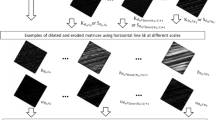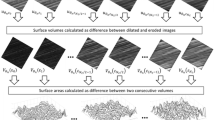Abstract
The detection of changes in surface texture characteristics is an important issue in manufacturing, contact mechanics, control of interactions between surfaces, machine failure analysis, and others. These changes can be detected early on when surface texture is quantified locally at each point. To this end, a new method called local directional fractal signature has recently been developed that calculates local fractal dimensions (FD = 3 − slope) at individual scales and directions. In this method, texture parameters are derived from the slopes of lines fitted to log–log plots of local surface profiles against scales, and FDs to measure local surface roughness and directionality. First, the method is tested on computer-generated isotropic fractal surfaces with the objective to evaluate its ability to differentiate between surfaces exhibiting an increasing local roughness. This follows the method application to detect the anisotropy changes in computer-generated surfaces with increasing roughness in two directions. Finally, the method’s detection ability in finding differences between surfaces is evaluated. Microscopic range-images of sandblasted and abraded titanium alloy plates are used in the evaluation. This work is a further contribution to the advancement in the characterization of surface textures, the numerical tools development for the design of tribological components and the diagnosis of worn and damaged surfaces. Practical applications of the method (e.g., classification of wear images, characterization of coated and uncoated surfaces) would be reported later in the future.








Similar content being viewed by others
Data Availability
Not applicable.
Code Availability
Not applicable.
References
ASME B46.1 Surface Texture, Surface Roughness, Waviness and Lay. Place (2002)
ISO 4287 Geometrical Product Specifications (GPS) -Surface Texture: Profile Method Terms, Definitions and Surface Texture Parameters (1997)
25178–2 Geometrical product specifications (gps) Surface texture: areal part 2: Terms, definitions and surface texture parameters. International Organization for Standardization, Place International Organization for Standardization (2012)
Articus, K., Brown, A.C., Wilhelm, W.P.: Scale-sensitive fractal analysis using the patchwork method for the assessment of skin roughness. Skin. Res. Technol. 7, 164–167 (2008)
Articus, K., Brown, A.C., Wilhelm, W.P.: Effect of food surface roughness on oil uptake by deep-fat fried products. J. Food. Eng. 101, 179–186 (2010)
Hasegawa, A., Itoh, K., Ichioka, Y.: Detection of cell membranes in human corneal endothelial micrograms using mathematical morphology. Jpn. J. App. Phys. 31, 798 (1992)
Talu, S., Stach, S., Zaharieva, J., Milanova, K., Todorovsky, D., Giovanzana, S.: Surface roughness characterization of poly(methylmethacrylate) films with immobilized Eu(III) B-Diketonates by fractal analysis. Int. J. Polym. Anal. Charact. 19, 404–421 (2014)
Dallaeva, D., Talu, S., Stach, S., Skarvada, P., Tomanek, P., Grmela, L.: AFM imaging and fractal analysis of surface roughness of AlN epilayers on sapphire substrates. Appl. Surf. Sci. 312, 81–86 (2014)
Qin, W., **, X., Kirk, A., Shipway, P., Sun, W.: Effects of surface roughness on local friction and temperature distributions in a steel-on-steel fretting contact. Tribol. Int. 120, 350–357 (2018)
Sigvant, M., Pilthammar, J., Hol, J., Wiebenga, J., Chezan, T., Carleer, B., et al.: Friction in sheet metal forming: influence of surface roughness and strain rate on sheet metal forming simulation results. Procedia. Manuf. 29, 512–519 (2019)
Puleo, D.A., Nanci, A.: Understanding and controlling the bone–implant interface. Biomaterials 20, 2311–2321 (1999)
Wen, C., Mudawar, I.: Modeling the effects of surface roughness on the emissivity of aluminum alloys. Int. J. Heat Mass Transf. 49, 4279–4289 (2006)
Podsiadlo, P., Wolski, M., Stachowiak, G.W.: Directional signatures of surface texture. Tribol. Lett. 67, 109 (2019)
Pentland, A.: Fractal-based description of natural scenes. IEEE Trans. Pattern Anal. Mach. Intell. 6, 661–674 (1984)
Novianto, S., Suzuki, Y., Maeda, J.: Near optimum estimation of local fractal dimension for image segmentation. Pattern Recognit. Lett. 24, 365–374 (2003)
Wenxue, J., Lam, N.S.N.: An improved algorithm for computing local fractal dimension using the triangular prism method. Comput. Geosci. 35, 1224–1233 (2009)
Bryan, J.B.: The Abbe principle revisit: an updated interpretation. Precis. Eng. 1, 129–132 (1979)
Whitehouse, D.J.: Handbook of Surface and Nanometrology. CRC Press, Boca Raton (2010)
Stein, M.L.: Fast and exact simulation of fractional Brownian surfaces. J. Comput. Graph. Stat. 11, 587–599 (2002)
Russ, J.C.: Fractal Surfaces. Plenum Press, New York (1994)
Backes, A., Gonçalves, W., Martinez, A., Bruno, O.: Texture analysis and classification using deterministic tourist walk. Pattern Recognit. 43, 685–694 (2010)
Gonçalves, W., Bruno, O.: Combining fractal and deterministic walkers for texture analysis and classification. Pattern Recognit. 46, 2953–2968 (2013)
de Rooij, M., Schipper, D.: A wear measurement method based on the comparison of local surface heights. Wear 217, 182–189 (1998)
Wolski, M., Woloszynski, T., Stachowiak, G.W., Podsiadlo, P.: Towards the automated classification system of worn surfaces. Proc. IMechE Part J 208–210, 1–10 (2019)
Wolski, M., Woloszynski, T., Podsladlo, P., Stachowiak, G.W.: En route to the automated wear surface classification system: differentiating between adhesive, abrasive, and corrosive wear under different load conditions. Tribol. Lett. 8, 87 (2020)
Wolski, M., Podsiadlo, P., Stachowiak, G., Holmberg, K., Laukkanen, A., Ronkainen, H., et al.: Multiscale characterisation of 3D surface topography of DLC coated and uncoated surfaces by directional blanket covering (DBC) method. Wear 388–389, 47–56 (2017)
Wolski, M., Podsiadlo, P., Stachowiak, G., Holmberg, K., Laukkanen, A., Ronkainen, H.: Characterization of DLC-coated and uncoated surfaces by new directional blanket curvature covering (DBCC) method. Tribol. Lett. 66, 153 (2018)
Laukkanen, A., Holmberg, K., Ronkainen, H., Stachowiak, G., Podsiadlo, P., Wolski, M., et al.: Topographical orientation effects on surface stresses influencing on wear in sliding DLC contacts, Part 2: Modelling and simulations. Wear 388–389, 18–28 (2017)
Xu, J., Zeng, W., Zhao, Y., Jia, Z.: Effect of microstructure evolution of the lamellar alpha on impact toughness in a two-phase titanium alloy. Mater. Sci. Eng. A 676, 434–440 (2016)
Crostack, H., Nellesen, J., Fischer, G., Weber, U., Schmauder, S., Beckmann, F.: 3D Analysis of MMC microstructure and deformation by mu CT and FE simulations. Proc. SPIE 7078, 70781I-70781–70711 (2008)
Stachowiak, G., Wolski, M., Woloszynski, T., Podsiadlo, P.: Detection and prediction of osteoarthritis in knee and hand joints based on the X-ray image analysis. Biosurf. Biotribol. 2, 162–172 (2016)
Podsiadlo, P., Nevitt, M.C., Wolski, M., Stachowiak, G.W., Lynch, J.A., Tolstykh, I., et al.: Baseline trabecular bone and its relation to incident radiographic knee osteoarthritis and increase in joint space narrowing score: directional fractal signature analysis in the MOST study. Osteoarthr. Cartil. 24, 1736–1744 (2016)
Wolski, M., Podsiadlo, P., Stachowiak, G.W.: Directional fractal signature analysis of trabecular bone: evaluation of different methods to detect early osteoarthritis in knee radiographs. Proc. Inst. Mech. Eng. H 223, 211–236 (2009)
Wolski, M., Podsiadlo, P., Stachowiak, G.W.: Analysis of AFM images of self-structured surface textures by directional fractal signature method. Tribol. Lett. 49, 465–480 (2013)
Wolski, M., Podsiadlo, P., Stachowiak, G.W.: Characterization of surface topography from small images. Tribol. Lett. 61, 2 (2016)
Acknowledgements
This research was supported under Australian Research Council’s Discovery Project funding scheme (Project No. DP180100700). The authors wish to thank the Curtin University and the School of Civil and Mechanical Engineering for their support during preparation of the manuscript.
Funding
Australian Research Council’s Discovery Project funding scheme (Project No. DP180100700).
Author information
Authors and Affiliations
Contributions
All authors contributed to the study conception and design. Individual authors contributed to the tasks of materials selection, methods, data collection and analysis. The first draft of the manuscript was written by Marcin Wolski. All the authors corrected and commented on subsequent versions of the manuscript. All authors read and approved the final version of the manuscript.
Corresponding author
Ethics declarations
Conflict of interest
The authors have no conflict of interest for this manuscript.
Ethical Approval
The study does not involve human participants nor biological material.
Additional information
Publisher's Note
Springer Nature remains neutral with regard to jurisdictional claims in published maps and institutional affiliations.
Rights and permissions
About this article
Cite this article
Wolski, M., Woloszynski, T., Podsiadlo, P. et al. Local Directional Fractal Signature Method for Surface Texture Analysis. Tribol Lett 70, 15 (2022). https://doi.org/10.1007/s11249-021-01547-2
Received:
Accepted:
Published:
DOI: https://doi.org/10.1007/s11249-021-01547-2




